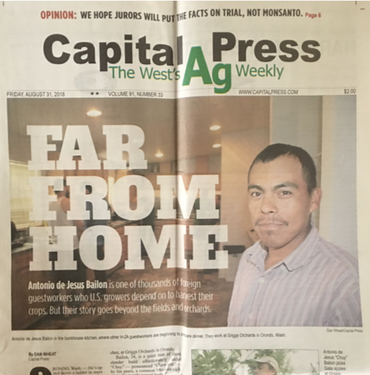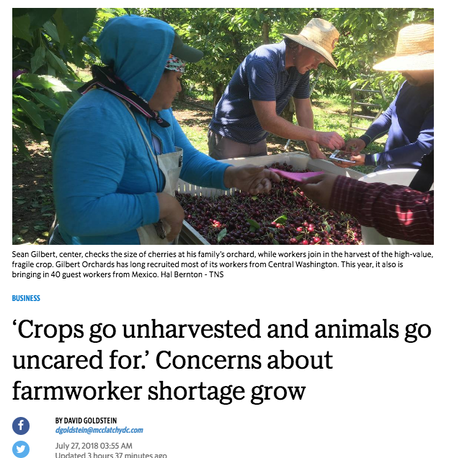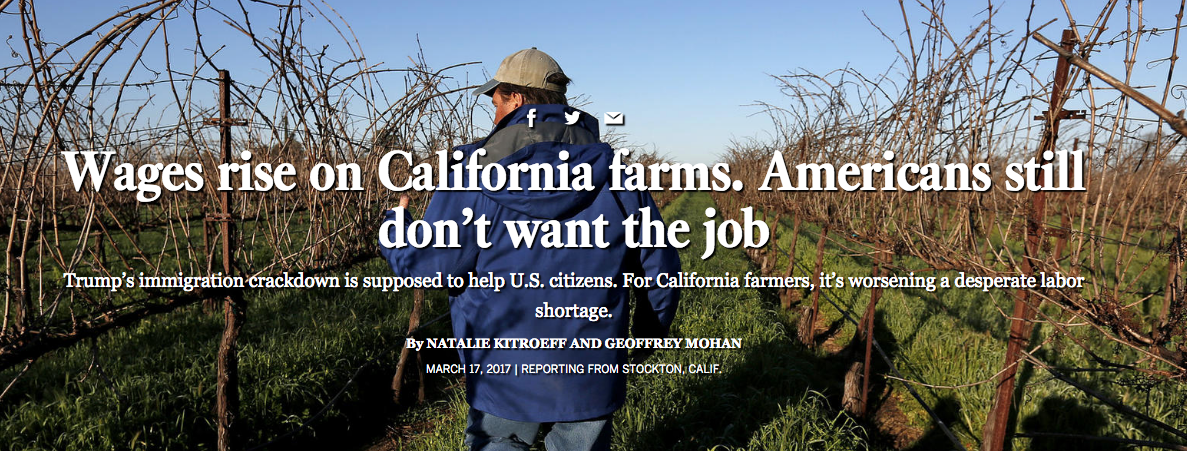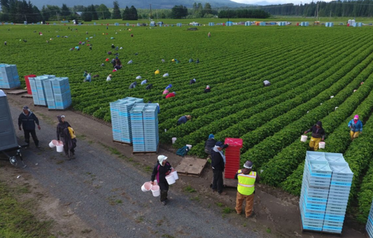 Union activists like to call them "slaves." They say they are abused, underpaid, forced to live in horrid conditions. They even say one farm caused the death of one of these through overwork, even though government officials determined he died of natural causes unrelated to work. What's the truth about guest workers? This article by Dan Wheat, published in the August 30, 2018 edition of Capital Press tells what being a guest worker is really like. Far from home: The H-2A guestworkerAntonio de Jesus Bailon is one of thousands of foreign guestworkers who U.S. growers depend on to harvest their crops. But their story goes beyond the fields and orchards.
ORONDO, Wash. — He’s up and down a ladder in mere seconds, picking apples quickly with both hands and placing them into the canvas bag strapped to his chest. It’s grab the ladder and on to the next trees. He’s moving fast because the Gala apples are sparse, most having been picked days earlier. This is the final sweep for apples that needed more time to ripen. Antonio de Jesus Bailon is a good picker, slightly faster than average. He picks a 700-800-pound bin of apples per hour, says his foreman, Gustavo Sanchez, at Griggs Orchards in Orondo. Bailon, 34, is a quiet man of short, slender build affectionately called “Chuy” — pronounced “Chew-wee” — by his peers, a common Mexican nickname for people named Jesus. “These are good apples,” he says, grabbing nicely sized red Gala at ground level. Bailon is one of a growing number of foreign guestworkers working on U.S. farms and orchards. He has received a temporary H-2A (agricultural) visa often used to pick tree fruit, berries or vegetables. His employer has obtained special permission from the federal government to hire him and bring him from his home in Mexico to work. It’s work most Americans don’t want to do, growers say. The number of H-2A workers is growing rapidly because domestic workers are becoming more scarce. Industry and government sources estimate 50 to 70 percent of domestic farmworkers already in the U.S. are illegal immigrants. It costs growers more to hire H-2A guestworkers but they represent an increasingly rare commodity for farmers — a legal, dependable workforce. Farmers need that, given the value of their crops. The annual farmgate value of Washington apples alone is $2.4 billion and the value of other labor-intensive crops throughout the nation is billions of dollars more. During the first three quarters of fiscal year 2018, Washington farmers hired 20,070 H-2A workers, according to the U.S. Department of Labor. That compares to 15,611 hired during the first three quarters of 2017 and 18,535 for all of last year. Washington farmers are in third place behind their counterparts in Florida and Georgia in hiring H-2A workers in the first three-quarters of this year. Before the harvest is finished, they may hire nearly 30,000, according to the farm labor association WAFLA. That would be an increase of about 60 percent from last year. Zirkle Fruit Co. of Selah, Wash., is the second largest single employer of H-2A workers in the nation, hiring 4,169 for the first three-quarters of this year. Nationally, 193,603 H-2A workers have been certified for the first three-quarters of 2018. That’s up from 160,084 for the same period in 2017 and about 8 percent of all farmworkers. The final 2018 tally will surpass the 200,049 that were hired for all of 2017. The need for guestworkers has spiraled upward during the past 13 years. In 2005, the total number of H-2A guestworkers hired nationwide was 48,336. The average length of stay for H-2A guestworkers in 2016 was 6.4 months. Meager roots Bailon was born, raised and still lives in Francisco Javier Mina, a village of about 950 people in the state of Durango, midway between the U.S. border and Mexico City. The village is 7,000 feet above sea level, and most residents make their living hand-picking beans and corn for 200 pesos — about $10.50 — per day, Bailon says. The median education there is six years of school. Bailon attended school for nine years. Of the town’s 316 dwellings, 98 percent have electricity, 1.6 percent have piped water, 74 percent have toilets, 96 percent have televisions, 55 percent have cars, 3.7 percent have computers and 0.4 percent have internet access, according to the census website en.mexico.pueblosamerica.com. Twenty households have dirt floors and five have just one room. Bailon’s parents have always picked beans and corn for a living, and he and his three siblings have done the same. “We had to work and help our parents from as early as we could for no wages,” he said. “It’s what we had to do to survive. We always had food but not a lot.” Good money Bailon and his wife, Carolina, have two daughters, ages 11 and 9, and a son who is just a few months old. Five years ago, he learned of the H-2A program through other workers and decided it was worth leaving home to make more money. He worked for Evans Fruit Co. in Mattawa orchards his first two years and now is in his third year at Griggs Orchards in Orondo. He was recruited through WAFLA. He came in mid-March to prune and train trees and will leave in mid-November when the last apples are picked. He will return home in time for several weeks of the local bean and corn harvest. For pruning and thinning in Orondo this season, he earned the H-2A minimum wage of $14.12 per hour and on piece rate during cherry harvest made $20 per hour. Piece rate is a rate of pay based on the amount of fruit picked. It’s an incentive for fast work. At Griggs Orchards the rate was $6 per 18-pound bucket for Rainier cherries and $3.25 for red cherries. The piece rate is $25 per bin for apples. Bailon averages one bin per hour, so he’s making $25 per hour, or $200 per day. “This is good. You don’t really make money in Mexico,” he said. At the minimum H-2A wage, he makes more in one hour than he makes during an entire day in Mexico. At the apple piece rate he earns about 19 times more per day. Bailon said he earned $18,000 on H-2A last year, used about $1,800 of that to live on while in the U.S., mostly for food, and took the rest home to his family, including his parents. He expects to make the same amount this year. The H-2A pay has enabled him to buy more clothes for his family, and now he’s building a new house. “But it’s hard being away from family,” he said. “It’s lonely. I do it because we need the money.” He says the H-2A job has enabled him to rise to the middle class. Previously, he considered himself to be poor. He hopes to continue in H-2A as long as he can and feels fortunate to have the opportunity. Changes ahead? Bills in Congress propose replacing the H-2A program with a new H-2C program in which growers no longer would have to provide housing and transportation between the job and guestworkers’ country of origin. They could also pay a lower minimum wage. Even if he had to pay for transportation and housing and accept a lower minimum wage, Bailon said he would still work in the U.S. because he could still make more money than in Mexico. He said he doesn’t follow congressional debates about guestworker programs or immigration. “In my opinion, everything is pretty good the way it is now,” he said. “I’d like to keep things the way they are.” He knows people who have immigrated to the U.S. illegally, but Bailon said he didn’t because the “risk is high and I’d rather do things the right way.” At Griggs Orchards, picking starts shortly after day break and ends by mid-afternoon. A relatively new bus carries the workers between the orchard and the bunkhouse that houses 20 workers in five rooms. Each room has four bunks and a television. There’s also a common kitchen and eating area. Bailon and his roommates watch TV or sometimes walk to the nearby Orondo School to play soccer. One of the roommates, Raul Ruiz, 25, previously picked apples in the state of Durango. “It gave me experience but we don’t make as much picking there,” he said. Bailon lives in a different part of Durango and didn’t have the opportunity to pick apples before coming to the U.S. Grower perspective John Griggs, co-owner of Griggs Orchards, says this is his third year of hiring H-2A workers. “There’s not a snowball’s chance in hell we would get our crops picked without it,” Griggs said of H-2A. “It’s just the lack of domestic workers. It keeps getting tighter and tighter every year. We really noticed the crunch a few years ago in cherries and last year in apples as well.” He hired 36 H-2A workers his first year, 60 last year and 104 this year out of his total peak workforce of 245 during cherry harvest in June and July. Most of his workers are still domestic, but the number keeps shrinking. Bailon and Ruiz are part of a crew of 20 H-2A guestworkers that came in March and will stay into November. Griggs hired 84 more in mid-May who stayed into July for cherries and then went to work at Valicoff Fruit Co. in Wapato, Wash. On June 19, the workers were in their first few days of picking Griggs’ Orondo Ruby cherries. They were all young men in their late teens and early 20s. They were intent on their work and didn’t talk or sing, as experienced domestic pickers often do. But they were slow. “They were first year out of Oaxaca and were very quiet. They wanted to do a good job. They were good workers, just not fast in that first week in cherries,” Griggs said. “Picking cherries is a tough thing, especially when you are picking for color and size right out of the gate,” he said. “But they were getting the knack after the first week and were eager to learn. I was impressed with them and would like to have them back. They all asked to come back next year.” Griggs paid $10 per night per worker to house the 84 in the Washington Growers League’s Brender Creek farmworker housing in Cashmere. Foreign guestworkers cost Griggs more, not just in transportation and housing but he has to pay his domestic workers the same minimum wage he pays those on H-2A visas and offer housing to those who live beyond a 50-mile radius. He also has to advertise for domestic workers through the first half of the H-2A contract. “We got a few that way during cherries but very few, maybe 15,” he said. “The downside is the cost and productivity of it the first couple of years. But having a stable, legal workforce outweighs all of that.”  Major national news report from McClatchy was published in the Bellingham Herald on the critical shortage of farm workers. This article highlights the growing role of guest workers, the high cost of guest workers, and why the current guest worker program needs to change. As reported here, the farm worker shortage is affecting farming of various types including dairy farms. The guest worker program as it stands does not help this because of the limited time workers are allowed in the country. Fortunately, there is an effort in Congress to make the guest worker program work much better to help alleviate the critical shortage of farm workers. This bill, HR6417, would address many of the concerns farmers have about the current guest worker program. https://newhouse.house.gov/media-center/press-releases/goodlatte-peterson-smith-cuellar-newhouse-conaway-calvert-introduce The LA Times reports on how much the worker shortage is causing wages to rise.
http://www.latimes.com/projects/la-fi-farms-immigration/ Sounds like a good thing. The problem is that our farms are already paying 20 to 30 times what farms in Mexico, Serbia, Peru, Bulgaria, Chile and China are paying. Paying more sounds like it is good for workers. But more farms are going out of business, and the larger farmers who can are mechanizing as fast as they can to reduce labor. Fewer smaller farms depending on farm workers. Fewer jobs all around. With farms paying $20 an hour and more, with workers able to earn $35 and hour and more during the peak of harvest, how much would it have to go up to attract more non-hispanic domestic workers? Wouldn't farmers love to be able to pay $50 an hour and more? But, how do they then compete against those farms paying $11 per day, or less than that in some countries. Activists say farmworkers forced to live in unhealthy and degraded conditions.
|
|||||||
| media-statement-from-sarbanand-farms-llc-02-01-18.pdf | |
| File Size: | 217 kb |
| File Type: | |
Details
Archives
December 2018
July 2018
February 2018


 RSS Feed
RSS Feed